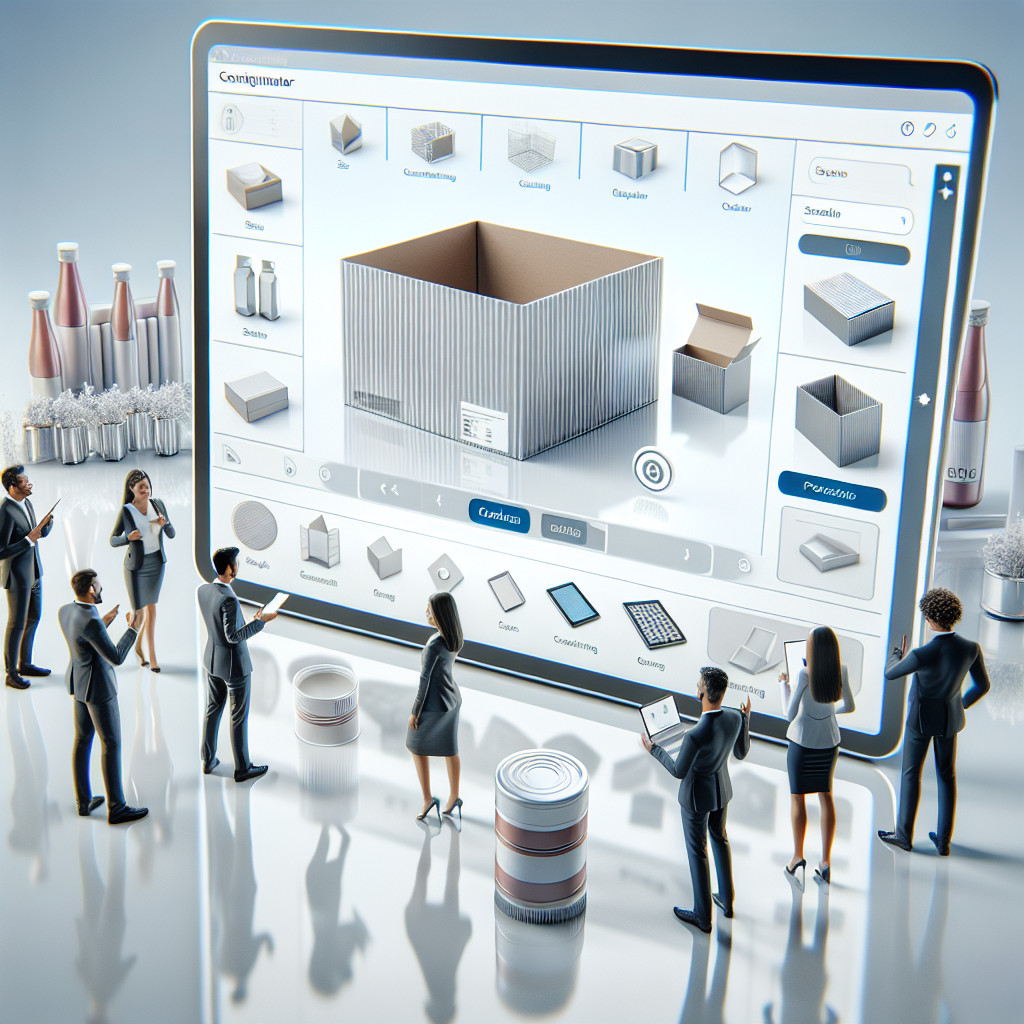
Product configurator for the packaging industry
- The benefits of using a product configurator in the packaging industry
- The role of a product configurator in reducing packaging waste
- How a product configurator can help packaging companies meet sustainability goals
- The role of a product configurator in improving packaging industry customer satisfaction
- The role of a product configurator in improving packaging industry compliance with regulations
- The role of a product configurator in enhancing packaging industry brand image
- The benefits of using a real-time pricing engine in a product configurator for the packaging industry
- The role of a product configurator in optimizing packaging industry material sourcing
The benefits of using a product configurator in the packaging industry
A product configurator is a software application that allows customers to customize and personalize their packaging products according to their specific needs and preferences. It provides a user-friendly interface where customers can select various options such as size, shape, color, material, and design elements. The configurator then generates a 3D visualization of the customized product, giving customers a realistic preview of what their packaging will look like.
One of the key benefits of using a product configurator in the packaging industry is the ability to offer a personalized and unique customer experience. By allowing customers to customize their packaging, companies can cater to individual preferences and create a sense of ownership and exclusivity. This not only enhances customer satisfaction but also helps build brand loyalty and differentiate from competitors.
Another advantage of using a product configurator is the reduction in lead times and costs associated with traditional manual processes. In the past, creating customized packaging required extensive communication between customers and designers, multiple iterations of prototypes, and lengthy production times. With a configurator, customers can instantly see the impact of their choices on the final product, eliminating the need for back-and-forth communication and reducing the time and cost involved in the design and production process.
Furthermore, a product configurator enables packaging companies to optimize their inventory management and production planning. By providing real-time data on customer preferences and demand patterns, companies can accurately forecast production needs and adjust their inventory levels accordingly. This helps minimize waste, reduce storage costs, and ensure timely delivery of customized packaging products.
Additionally, a product configurator can significantly improve the efficiency of the sales process. Sales representatives can use the configurator as a visual aid during customer consultations, allowing them to showcase different options and quickly generate quotes based on the customer’s selections. This not only saves time but also helps sales teams close deals faster and increase conversion rates.
In terms of marketing and branding, a product configurator can be a powerful tool for showcasing a company’s capabilities and product range. By offering a visually engaging and interactive experience, companies can effectively communicate their expertise, quality, and innovation to potential customers. This can help attract new customers, strengthen existing customer relationships, and position the company as a leader in the packaging industry.
In conclusion, the benefits of using a product configurator in the packaging industry are numerous. From enhancing customer satisfaction and loyalty to improving operational efficiency and reducing costs, these digital tools have become an essential part of modern packaging companies. By embracing this technology, companies can stay ahead of the competition, meet the evolving demands of customers, and drive growth in an increasingly competitive market.
Keywords: product configurator, packaging industry, customization, customer satisfaction, efficiency, lead times, costs, inventory management, production planning, sales process, marketing, branding.
Long-tail phrases: personalized customer experience, reduction in lead times and costs, optimization of inventory management, improved sales efficiency, visual aid during consultations, marketing and branding tool.
The role of a product configurator in reducing packaging waste
One of the main reasons why a product configurator can help reduce packaging waste is its ability to eliminate the need for excessive packaging. Traditional manufacturing processes often involve producing products in large quantities and packaging them in standardized boxes or containers. This approach leads to a significant amount of packaging waste, as many products end up being over-packaged. However, with a product configurator, customers can design their products to fit their exact specifications, eliminating the need for excessive packaging.
Furthermore, a product configurator can also help reduce packaging waste by optimizing the use of materials. By allowing customers to choose the materials used in their products, a configurator can ensure that only the necessary amount of materials is used, minimizing waste. For example, if a customer wants a product made from sustainable materials, they can select those options in the configurator, reducing the need for non-recyclable or non-biodegradable packaging materials.
Another way a product configurator can contribute to reducing packaging waste is by enabling manufacturers to implement just-in-time production. Just-in-time production is a manufacturing strategy that aims to produce goods only when they are needed, eliminating excess inventory and reducing waste. By using a product configurator, manufacturers can produce products based on customer orders, ensuring that they are only producing what is necessary. This approach not only reduces packaging waste but also minimizes the overall environmental impact of the manufacturing process.
In addition to reducing packaging waste, a product configurator can also have a positive impact on customer satisfaction. By allowing customers to personalize their products, a configurator enhances the overall shopping experience. Customers feel more connected to the products they design, leading to increased customer loyalty and repeat purchases. This, in turn, can lead to a reduction in returns and exchanges, further reducing waste associated with packaging and transportation.
In conclusion, a product configurator plays a crucial role in reducing packaging waste. By eliminating excessive packaging, optimizing material usage, and enabling just-in-time production, a configurator can significantly minimize the environmental impact of the manufacturing process. Additionally, it enhances customer satisfaction and loyalty, leading to a more sustainable and profitable business model. As the world continues to prioritize sustainability, the use of product configurators is likely to become more widespread, benefiting both the environment and businesses.
Keywords: product configurator, packaging waste, customization, personalized products, environmental concerns, e-commerce, waste reduction, manufacturing processes, excessive packaging, materials optimization, just-in-time production, customer satisfaction, customer loyalty, sustainable business model.
Long-tail phrases:
– The impact of a product configurator on reducing packaging waste
– How a product configurator can minimize excessive packaging
– The role of a product configurator in optimizing material usage
– Just-in-time production and its contribution to reducing packaging waste
– Enhancing customer satisfaction through product customization
– The link between product configurators and sustainable business practices.
How a product configurator can help packaging companies meet sustainability goals
One of the key ways in which a product configurator helps packaging companies meet their sustainability goals is by minimizing overproduction. Traditionally, packaging companies would produce large quantities of standardized products, leading to excess inventory and waste. With a product configurator, customers can select the exact specifications they need, ensuring that only the necessary amount of materials are used. This not only reduces waste but also saves costs for both the packaging company and the customer.
Furthermore, a product configurator enables packaging companies to optimize their supply chain and reduce transportation-related emissions. By offering customization options, companies can produce packaging products closer to the point of consumption, minimizing the need for long-distance shipping. This not only reduces carbon emissions but also improves overall efficiency and responsiveness to customer demands.
Another significant benefit of using a product configurator is the ability to promote the use of sustainable materials. Packaging companies can provide customers with a range of eco-friendly options, such as biodegradable or recyclable materials, through the configurator. This encourages customers to make more sustainable choices and reduces the environmental impact of packaging products.
Moreover, a product configurator can help packaging companies streamline their production processes and reduce energy consumption. By automating the customization process, companies can eliminate manual labor and reduce the time and energy required to produce each order. This not only improves efficiency but also reduces the carbon footprint associated with manufacturing.
In addition to these environmental benefits, a product configurator also offers several advantages for packaging companies in terms of business growth and customer satisfaction. By offering customization options, companies can differentiate themselves from competitors and attract a wider customer base. Customers appreciate the ability to personalize their packaging products, leading to increased brand loyalty and repeat business.
In conclusion, a product configurator is a valuable tool for packaging companies looking to meet their sustainability goals. By minimizing overproduction, optimizing the supply chain, promoting sustainable materials, and reducing energy consumption, packaging companies can significantly reduce their environmental impact. Additionally, the use of a product configurator offers business advantages such as increased customer satisfaction and brand loyalty. As sustainability continues to be a priority for consumers and businesses alike, investing in a product configurator is a strategic move for packaging companies.
Keywords: product configurator, packaging companies, sustainability goals, waste reduction, customization options, supply chain optimization, sustainable materials, energy consumption, business growth, customer satisfaction.
Long-tail phrases:
– How can a product configurator help packaging companies meet sustainability goals?
– The benefits of using a product configurator for packaging companies’ sustainability efforts.
– Reducing waste and promoting sustainability with a product configurator.
– The role of customization in achieving packaging companies’ sustainability goals.
– Streamlining production processes and reducing energy consumption with a product configurator.
The role of a product configurator in improving packaging industry customer satisfaction
One of the key benefits of using a product configurator in the packaging industry is the ability to offer a personalized experience to customers. By allowing them to customize their packaging products, companies can cater to individual preferences and create a sense of ownership. This not only enhances customer satisfaction but also increases brand loyalty and repeat business.
Moreover, a product configurator streamlines the ordering process, making it more efficient and error-free. Traditionally, customers had to rely on manual communication with packaging companies, which often led to misinterpretations and mistakes. With a configurator, customers can directly input their requirements, eliminating the chances of miscommunication. This not only saves time but also reduces the risk of costly errors.
Additionally, a product configurator enables packaging companies to offer a wider range of options to customers. By digitizing the customization process, companies can easily manage and update their product catalog, allowing customers to choose from a vast array of options. This not only enhances customer satisfaction but also opens up new revenue streams for packaging companies.
Furthermore, a product configurator provides valuable insights into customer preferences and market trends. By analyzing the data collected through the configurator, companies can identify popular customization options, understand customer behavior, and make informed business decisions. This data-driven approach helps packaging companies stay ahead of the competition and deliver products that meet customer expectations.
In conclusion, cannot be overstated. By offering a personalized experience, streamlining the ordering process, providing a wider range of options, and offering valuable insights, a configurator enhances customer satisfaction, increases brand loyalty, and drives business growth.
Keywords: product configurator, packaging industry, customer satisfaction, customization, personalization, 3D visualization, efficient ordering process, brand loyalty, error-free, wider range of options, data-driven approach, business growth.
Long-tail phrases:
– The benefits of using a product configurator in the packaging industry
– How a product configurator enhances customer satisfaction in the packaging industry
– Streamlining the ordering process with a product configurator
– The impact of a product configurator on brand loyalty in the packaging industry
– Expanding options for customers with a product configurator in the packaging industry
– Leveraging data insights from a product configurator in the packaging industry
– The role of a product configurator in driving business growth in the packaging industry.
The role of a product configurator in improving packaging industry compliance with regulations
One of the main benefits of using a product configurator is that it streamlines the design process. Packaging companies can input the necessary parameters, such as the type of product, its dimensions, and weight, and the configurator will generate a range of packaging options that meet the required regulations. This eliminates the need for manual calculations and reduces the risk of non-compliance.
Moreover, a product configurator allows packaging companies to experiment with different materials and designs. They can easily compare the environmental impact of different packaging options and choose the most sustainable solution. This not only helps them meet regulatory requirements but also enhances their brand image as environmentally responsible companies.
Another important aspect of compliance in the packaging industry is labeling. Packaging companies need to ensure that their products are properly labeled with all the necessary information, such as product name, ingredients, and recycling instructions. A product configurator can automate this process by generating accurate and compliant labels based on the packaging design. This reduces the risk of errors and ensures that the packaging meets all the necessary labeling requirements.
Furthermore, a product configurator can help packaging companies stay up to date with the ever-changing regulatory landscape. It can be integrated with regulatory databases and automatically update the packaging designs based on the latest regulations. This ensures that the packaging remains compliant even as regulations evolve.
In addition to compliance, a product configurator also offers other benefits to the packaging industry. It improves efficiency by automating the design process, reduces costs by optimizing material usage, and enhances customer satisfaction by providing customized packaging solutions. These benefits contribute to the overall competitiveness and success of packaging companies.
In conclusion, a product configurator plays a crucial role in improving packaging industry compliance with regulations. It streamlines the design process, enables experimentation with sustainable materials, automates labeling, and helps companies stay up to date with regulatory changes. By utilizing a product configurator, packaging companies can ensure that their packaging solutions are not only visually appealing but also compliant with the necessary regulations.
Keywords: product configurator, packaging industry, compliance, regulations, sustainability, environmental, design process, material usage, recycling, waste management, labeling, brand image, labeling requirements, efficiency, costs, customer satisfaction, competitiveness.
Long-tail phrases:
– The importance of a product configurator in meeting packaging industry compliance regulations
– How a product configurator can help packaging companies design sustainable packaging solutions
– The role of a product configurator in automating the labeling process for packaging
– The benefits of using a product configurator in the packaging industry
– How a product configurator can help packaging companies stay up to date with regulatory changes.
The role of a product configurator in enhancing packaging industry brand image
One of the key ways in which a product configurator enhances brand image is by offering a unique and personalized experience to customers. By allowing them to create their own packaging designs, companies can tap into the growing trend of customization and individuality. This not only makes customers feel more connected to the brand but also helps in creating a sense of exclusivity and differentiation. When customers receive packaging that is tailored to their preferences, they are more likely to perceive the brand as innovative, customer-centric, and trustworthy.
Moreover, a product configurator can also contribute to enhancing brand image by improving the overall customer experience. Traditionally, the process of ordering customized packaging products involved multiple steps, including back-and-forth communication with sales representatives, lengthy lead times, and the risk of miscommunication. With a product configurator, customers can easily and efficiently design their packaging online, eliminating the need for manual intervention and reducing the chances of errors. This streamlined process not only saves time but also enhances customer satisfaction, as they can have a hassle-free experience from start to finish.
Furthermore, a product configurator can also serve as a powerful marketing tool for packaging companies. By integrating the configurator into their website or e-commerce platform, companies can attract more visitors and generate leads. The configurator acts as a visual and interactive tool that engages customers and encourages them to explore different options. This not only increases the time spent on the website but also provides valuable data on customer preferences and trends. Companies can then use this data to refine their product offerings, target specific customer segments, and develop more effective marketing strategies.
In conclusion, a product configurator plays a vital role in enhancing the brand image of packaging companies. By offering customers the ability to customize and personalize their packaging products, it creates a unique and personalized experience that fosters a strong connection between the brand and the customer. Additionally, the configurator improves the overall customer experience by streamlining the ordering process and reducing the chances of errors. Lastly, it serves as a powerful marketing tool that attracts more visitors, generates leads, and provides valuable insights into customer preferences. By leveraging the capabilities of a product configurator, packaging companies can differentiate themselves from the competition and establish a strong and positive brand image.
Keywords: product configurator, packaging industry, brand image, customization, personalization, customer experience, marketing tool, differentiation, customer-centric, innovation, exclusivity, trustworthiness.
Long-tail phrases: enhancing brand image in the packaging industry, the role of customization in packaging, the impact of a product configurator on customer satisfaction, leveraging technology in the packaging industry, the importance of personalization in brand perception.
The benefits of using a real-time pricing engine in a product configurator for the packaging industry
However, the challenge for packaging companies is to provide accurate pricing information to customers in real-time. Traditionally, pricing calculations were done manually, which was time-consuming and prone to errors. This often resulted in delays in providing quotes to customers, leading to a loss of business opportunities.
By integrating a real-time pricing engine into a product configurator, packaging companies can overcome these challenges. A real-time pricing engine is a software tool that calculates the cost of a customized packaging solution based on the selected options and variables. It takes into account factors such as material costs, production costs, and any additional features or services requested by the customer.
The benefits of using a real-time pricing engine in a product configurator are numerous. Firstly, it allows packaging companies to provide instant and accurate pricing information to customers. This enables customers to make informed decisions about their packaging requirements and budget. It also eliminates the need for manual calculations, saving time and reducing the risk of errors.
Secondly, a real-time pricing engine enables packaging companies to offer competitive pricing to customers. By analyzing market trends and competitor pricing, the engine can suggest optimal pricing strategies that maximize profitability while remaining attractive to customers. This helps packaging companies to stay competitive in a rapidly changing market.
Furthermore, a real-time pricing engine can improve the overall customer experience. By providing instant pricing information, customers can quickly evaluate different options and make decisions without the need for back-and-forth communication with the packaging company. This streamlines the ordering process and enhances customer satisfaction.
In addition, a real-time pricing engine can generate valuable data and insights for packaging companies. By analyzing pricing trends, customer preferences, and sales data, companies can identify opportunities for product innovation, cost optimization, and market expansion. This data-driven approach can help packaging companies to make informed business decisions and drive growth.
In conclusion, the use of a real-time pricing engine in a product configurator offers numerous benefits to packaging companies. It enables them to provide instant and accurate pricing information to customers, offer competitive pricing, improve the customer experience, and generate valuable data and insights. By embracing this technology, packaging companies can stay ahead of the competition and meet the evolving needs of their customers.
Keywords: packaging industry, product configurator, real-time pricing engine, customization, accurate pricing, competitive pricing, customer experience, data-driven insights, market trends, profitability.
Long-tail phrases: benefits of using a real-time pricing engine in a product configurator for the packaging industry, challenges in providing accurate pricing information in real-time, advantages of a real-time pricing engine in a product configurator, improving customer experience with a real-time pricing engine, generating valuable data and insights with a real-time pricing engine.
The role of a product configurator in optimizing packaging industry material sourcing
One of the key benefits of using a product configurator in the packaging industry is the ability to optimize material sourcing. Traditionally, companies would rely on manual processes and guesswork to determine the most suitable materials for their packaging needs. This often led to inefficiencies and wastage of resources. However, with a product configurator, companies can input their specific requirements and preferences, and the software will generate a list of suitable materials that meet these criteria. This not only saves time and effort but also ensures that companies are sourcing materials that are best suited for their packaging needs.
Another advantage of using a product configurator in material sourcing is the ability to consider sustainability criteria. With the increasing focus on environmental sustainability, companies in the packaging industry are under pressure to use materials that are eco-friendly and have a minimal impact on the environment. A product configurator can help companies in this regard by providing a list of sustainable materials that meet the required specifications. This allows companies to make informed decisions and choose materials that align with their sustainability goals.
Furthermore, a product configurator can also help in optimizing the cost of material sourcing. By considering factors such as material availability, pricing, and supplier options, the software can generate a list of materials that offer the best value for money. This allows companies to make cost-effective decisions and minimize their material sourcing expenses. Additionally, the configurator can also provide insights into alternative materials or suppliers that may offer better pricing or availability, further optimizing the sourcing process.
In conclusion, is significant. By using a product configurator, companies can streamline their material sourcing processes, ensure the use of suitable materials, consider sustainability criteria, and optimize costs. This not only improves efficiency but also helps companies meet the growing demand for sustainable packaging solutions. As the packaging industry continues to evolve, the use of advanced technologies such as product configurators will become increasingly important in driving innovation and sustainability.
Keywords: product configurator, packaging industry, material sourcing, optimization, sustainability, customization, efficiency, cost-effective, eco-friendly, innovation.
Long-tail phrases:
– The benefits of using a product configurator in the packaging industry
– How a product configurator can optimize material sourcing in the packaging industry
– The role of sustainability in material sourcing for the packaging industry
– Cost optimization through product configurators in the packaging industry
– The future of material sourcing in the packaging industry.
- Sure! Here are some questions related to How Software House Poland supports IoT-enabled businesses: - 29 September 2025
- Laser cleaning: A valuable tool for removing corrosion from metal pipes. - 25 March 2024
- Product configurator for the packaging industry - 21 December 2023




